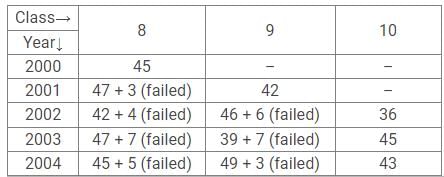MCQ Test: Missing Data Interpretation - 1 - Banking Exams MCQ
20 Questions MCQ Test - MCQ Test: Missing Data Interpretation - 1
Directions: Study the following information carefully and answer the given questions:
The given table shows the number of three different color balls in four different boxes.

Q. The average number of blue balls in all the boxes together is 15 and the number of blue balls in B is equal the number of red balls in box D. What is the average number of balls in D?

Directions: Study the following information carefully and answer the given questions:
The given table shows the number of three different color balls in four different boxes.

Q. Ratio of the number of red balls in B and D is 2:1 and average number of balls in box B is 25. If the total number of red balls in all the boxes together is 75, what is the number of blue balls in box B?

Directions: Study the following information carefully and answer the given questions:
The given table shows the number of three different color balls in four different boxes.

Q. Total number of balls in box D is 45 and the ratio of the number of red balls in D to the number of yellow balls in A is 3:4. What is the total number of balls in A?

Directions: Study the following information carefully and answer the given questions:
The given table shows the number of three different color balls in four different boxes.

Q. Average number of balls in C is 21 and the average number of yellow balls in all the boxes together is 15. What is the ratio of the number of yellow balls in A to the number of blue balls in D?
Directions: Study the following information carefully and answer the given questions:
The given table shows the number of three different color balls in four different boxes.

Q. Total number of balls in all the boxes together is 200. Ratio of the total number of balls in A, B, C and D is 9 : 9 : 13 : 9 and ratio of the red and blue balls in B is 2 : 3. What is the ratio of the number of yellow balls in A and C together to the number of red balls in B and D together?
Directions: Study the following table chart carefully and answer the questions given beside.
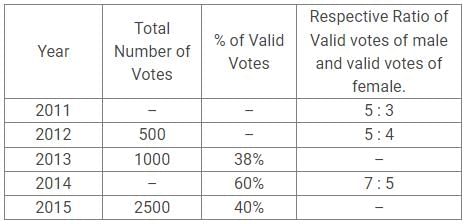
Q. In 2013, if the number of valid votes of female was 100, what was the respective ratio of number of valid votes of male and number of valid votes of female in the same year?
Directions: Study the following table chart carefully and answer the questions given beside.

Q. In 2011, the respective ratio of total number of votes to valid votes was 5 : 4. Number of valid votes of female in 2011 constitutes what percent of the total number of votes in the same year?
Directions: Study the following table chart carefully and answer the questions given beside.
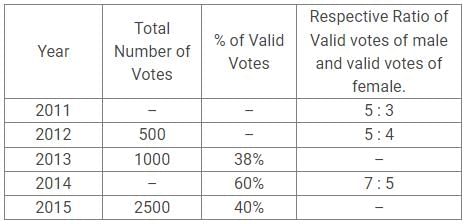
Q. The total number of votes increased by 50% from 2012 to 2016. If 16% of the votes were valid in 2016, what was the number of valid votes in 2016?
Directions: Study the following table chart carefully and answer the questions given beside.

Q. If the average number of valid votes in 2012 and 2015 was 635, what was the number of votes given by female in 2012?
Directions: Study the following table chart carefully and answer the questions given beside.
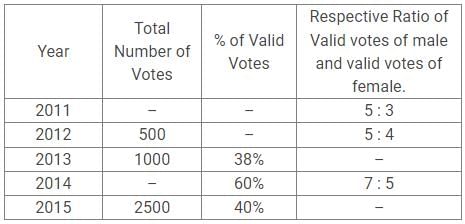
Q. In 2014, if the difference between number of valid votes of male and number of valid votes of female was 150, what was the total number of votes in 2014?
Directions: Study the following information carefully and answer the questions given below.
The given table shows the number of students in four different colleges in four different departments.

Q. If the average number of ECE students from all the colleges together is 430 and the number of ECE students from D is equal to the number of ME students from A. What is the ratio of the number of ECE students from A to the number of CSE students from D?
Directions: Study the following information carefully and answer the questions given below.
The given table shows the number of students in four different colleges in four different departments.

Q. If the total number of students from college A is equal to the total number of ME students from all the colleges together. The number of ECE students from college C is approximately what percent of the total number of students from college A all the departments together?
Directions: Study the following information carefully and answer the questions given below.
The given table shows the number of students in four different colleges in four different departments.

Q. If the ratio of the number of ME students from B to C is 24 : 19, what is the number of CSE students from C?
Directions: Study the following information carefully and answer the questions given below.
The given table shows the number of students in four different colleges in four different departments.

Q. Total number of EEE students from all the colleges together is 1900, then what is the number of ME students from B?
Directions: Study the following information carefully and answer the questions given below.
The given table shows the number of students in four different colleges in four different departments.

Q. If the ratio of the number of students of CSE from A to C is 21:32, find the number of ME students from C?
Directions: Read the following table chart carefully and answer the questions given beside.
The following table shows the number of students in classes 8, 9 and 10 in a school. The school started in 2000 and students are admitted only in class 8. At the end of the year the students who pass the final exams get promoted to the next class while the students who fail stay in the same class and are joined by a new bunch of students, who are either promoted (class 9 and 10) or who joined the school new (class 8). All students who pass the class 10 exams pass out of the school.
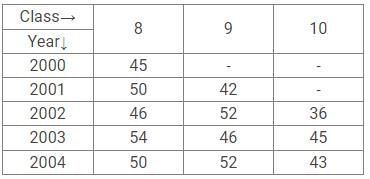
No student in class 10 failed in any of the years and no student failed in the same class more than once.
Q. How many students joined the school from 2000 to 2004?
Directions: Read the following table chart carefully and answer the questions given beside.
The following table shows the number of students in classes 8, 9 and 10 in a school. The school started in 2000 and students are admitted only in class 8. At the end of the year the students who pass the final exams get promoted to the next class while the students who fail stay in the same class and are joined by a new bunch of students, who are either promoted (class 9 and 10) or who joined the school new (class 8). All students who pass the class 10 exams pass out of the school.
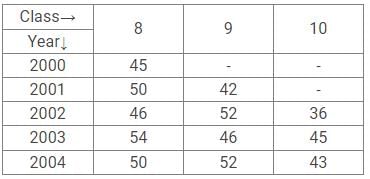
No student in class 10 failed in any of the years and no student failed in the same class more than once.
Q. What percentage of the students who joined the school from 2000 to 2002, passed out of the school by 2003?
Directions: Read the following table chart carefully and answer the questions given beside.
The following table shows the number of students in classes 8, 9 and 10 in a school. The school started in 2000 and students are admitted only in class 8. At the end of the year the students who pass the final exams get promoted to the next class while the students who fail stay in the same class and are joined by a new bunch of students, who are either promoted (class 9 and 10) or who joined the school new (class 8). All students who pass the class 10 exams pass out of the school.

No student in class 10 failed in any of the years and no student failed in the same class more than once.
Q. Approximately what percentage of the students in class 8 in 2002, passed the final exams?
Directions: Read the following table chart carefully and answer the questions given beside.
The following table shows the number of students in classes 8, 9 and 10 in a school. The school started in 2000 and students are admitted only in class 8. At the end of the year the students who pass the final exams get promoted to the next class while the students who fail stay in the same class and are joined by a new bunch of students, who are either promoted (class 9 and 10) or who joined the school new (class 8). All students who pass the class 10 exams pass out of the school.
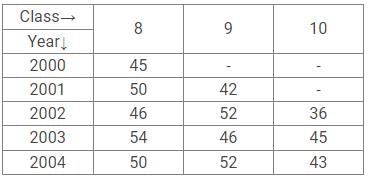
No student in class 10 failed in any of the years and no student failed in the same class more than once.
Q. How many students studying in class 9 in the year 2003, failed in the final exams?
Directions: Read the following table chart carefully and answer the questions given beside.
The following table shows the number of students in classes 8, 9 and 10 in a school. The school started in 2000 and students are admitted only in class 8. At the end of the year the students who pass the final exams get promoted to the next class while the students who fail stay in the same class and are joined by a new bunch of students, who are either promoted (class 9 and 10) or who joined the school new (class 8). All students who pass the class 10 exams pass out of the school.
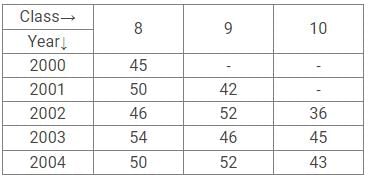
No student in class 10 failed in any of the years and no student failed in the same class more than once.
Q. The total number of students who failed in class 8 from 2000 to 2003 is




